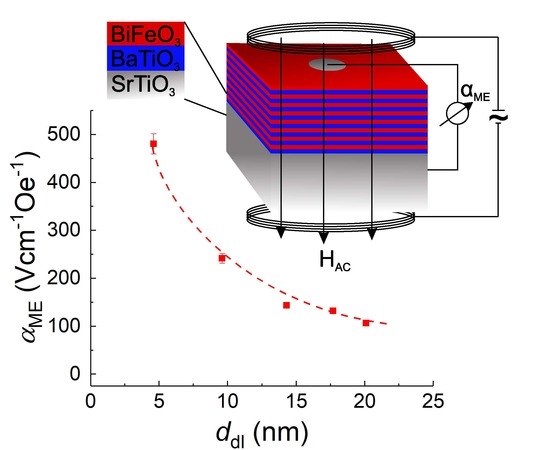Enhanced Magnetoelectric Coupling in BaTiO3-BiFeO3 Multilayers—An Interface Effect
Abstract
1. Introduction
- Does the BTO-BFO thickness ratio have an explicit influence on ?
- Does an explicit dependence on the double layer thickness exist?
- Can the dependence be verified with constant ?
2. Materials and Methods
2.1. Sample Preparation
2.2. Structural Characterization
2.3. Magnetic, Ferroelectric and Magnetoelectric Characterization
3. Results
3.1. X-ray Diffraction Measurements
3.2. TEM
3.3. Ferroelectric and Magnetic Measurements
3.4. Magnetoelectric Measurements
4. Discussion
5. Conclusions
Supplementary Materials
Author Contributions
Funding
Acknowledgments
Conflicts of Interest
Abbreviations
| magnetoelectric voltage coefficient | |
| double layer thickness | |
| ME | magnetoelectric |
| PLD | pulsed laser deposition |
| BTO | BaTiO3 |
| BFO | BiFeO3 |
| STO | SrTiO3 |
| RSM | reciprocal space map |
| FWHM | full width at half maximum |
| TEM | Transmission electron microscope |
| HR-TEM | high-resolution transmission electron microscopy |
| PPMS | physical property measurement system |
| VSM | vibrating sample magnetometer |
| XRR | X-ray reflectometry |
| XRD | X-ray diffraction |
| OOT | oxygen octahedral tilt |
References
- Fusil, S.; Garcia, V.; Barthélémy, A.; Bibes, M. Magnetoelectric Devices for Spintronics. Annu. Rev. Mater. Res. 2014, 44, 91–116. [Google Scholar] [CrossRef]
- Tu, C.; Chu, Z.; Spetzler, B.; Hayes, P.; Dong, C.; Liang, X.F.; Chen, H.; He, Y.; Wei, Y.; Lisenkov, I.; et al. Mechanical-Resonance-Enhanced Thin-Film Magnetoelectric Heterostructures for Magnetometers, Mechanical Antennas, Tunable RF Inductors, and Filters. Materials 2019, 12, 2259. [Google Scholar] [CrossRef]
- Hu, J.M.; Chen, L.Q.; Nan, C.W. Multiferroic Heterostructures Integrating Ferroelectric and Magnetic Materials. Adv. Mater. 2016, 28, 15–39. [Google Scholar] [CrossRef]
- Srinivasan, G. Magnetoelectric Composites. Annu. Rev. Mater. Res. 2010, 40, 153–178. [Google Scholar] [CrossRef]
- Dong, S.; Liu, J.M. Recent Progress of Multiferroic Perovskite Manganites. J. Phys. Chem. B 2012, 104, 6694–6709. [Google Scholar] [CrossRef]
- Lorenz, M.; Lazenka, V.; Schwinkendorf, P.; Bern, F.; Ziese, M.; Modarresi, H.; Volodin, A.; Van Bael, M.J.; Temst, K.; Vantomme, A.; et al. Multiferroic BaTiO3-BiFeO3 composite thin films and multilayers: strain engineering and magnetoelectric coupling. J. Phys. Appl. Phys. 2014, 47, 135303. [Google Scholar] [CrossRef]
- Lazenka, V.V.; Zhang, G.; Vanacken, J.; Makoed, I.I.; Ravinski, F.; Moshchalkov, V.V. Structural transformation and magnetoelectric behaviour in Bi(1−x)Gd(x)FeO(3) multiferroics. J. Phys. Appl. Phys. 2012, 45, 125002. [Google Scholar] [CrossRef]
- Lorenz, M.; Wagner, G.; Lazenka, V.; Schwinkendorf, P.; Modarresi, H.; Van Bael, M.J.; Vantomme, A.; Temst, K.; Oeckler, O.; Grundmann, M. Correlation of magnetoelectric coupling in multiferroic BaTiO3-BiFeO3 superlattices with oxygen vacancies and antiphase octahedral rotations. Appl. Phys. Lett. 2015, 106, 012905. [Google Scholar] [CrossRef]
- Lorenz, M.; Lazenka, V.; Schwinkendorf, P.; Van Bael, M.J.; Vantomme, A.; Temst, K.; Grundmann, M.; Höche, T. Epitaxial Coherence at Interfaces as Origin of High Magnetoelectric Coupling in Multiferroic BaTiO3-BiFeO3 Superlattices. Adv. Mater. Interfaces 2016, 3, 1500822. [Google Scholar] [CrossRef]
- Lazenka, V.; Lorenz, M.; Modarresi, H.; Bisht, M.; Rüffer, R.; Bonholzer, M.; Grundmann, M.; Van Bael, M.J.; Vantomme, A.; Temst, K. Magnetic spin structure and magnetoelectric coupling in BiFeO3-BaTiO3 multilayer. Appl. Phys. Lett. 2015, 106, 082904. [Google Scholar] [CrossRef]
- Lazenka, V.; Jochum, J.K.; Lorenz, M.; Modarresi, H.; Gunnlaugsson, H.P.; Grundmann, M.; Van Bael, M.J.; Temst, K.; Vantomme, A. Interface induced out-of-plane magnetic anisotropy in magnetoelectric BiFeO3-BaTiO3 superlattices. Appl. Phys. Lett. 2017, 110, 092902. [Google Scholar] [CrossRef]
- Jochum, J.K.; Lorenz, M.; Gunnlaugsson, H.P.; Patzig, C.; Höche, T.; Grundmann, M.; Vantomme, A.; Temst, K.; Van Bael, M.J.; Lazenka, V. Impact of magnetization and hyperfine field distribution on high magnetoelectric coupling strength in BaTiO3-BiFeO3 multilayers. Nanoscale 2018, 10, 5574–5580. [Google Scholar] [CrossRef] [PubMed]
- Hohenberger, S.; Lazenka, V.; Temst, K.; Selle, S.; Patzig, C.; Höche, T.; Grundmann, M.; Lorenz, M. Effect of double layer thickness on magnetoelectric coupling in multiferroic BaTiO3-Bi0.95Gd0.05FeO3 multilayers. J. Phys. Appl. Phys. 2018, 51, 184002. [Google Scholar] [CrossRef]
- Lorenz, M.; Hirsch, D.; Patzig, C.; Höche, T.; Hohenberger, S.; Hochmuth, H.; Lazenka, V.; Temst, K.; Grundmann, M. Correlation of Interface Impurities and Chemical Gradients with High Magnetoelectric Coupling Strength in Multiferroic BiFeO3-BaTiO3 Superlattices. ACS Appl. Mater. Interfaces 2017, 9. [Google Scholar] [CrossRef]
- Avellaneda, M.; Harshé, G. Magnetoelectric Effect in Piezoelectric/Magnetostrictive Multilayer (2-2) Composites. J. Intell. Mater. Syst. Struct. 1994, 5, 501–513. [Google Scholar] [CrossRef]
- Bichurin, M.I.; Petrov, V.M.; Srinivasan, G. Theory of low-frequency magnetoelectric coupling in magnetostrictive-piezoelectric bilayers. Phys. Rev. 2003, 68, 054402. [Google Scholar] [CrossRef]
- Vaz, C.F.; Hoffman, J.; Ahn, C.H.; Ramesh, R. Magnetoelectric coupling effects in multiferroic complex oxide composite structures. Adv. Mater. 2010, 22, 2900–2918. [Google Scholar] [CrossRef]
- Lorenz, M. Pulsed Laser Deposition of ZnO-Based Thin Films. In Transparent Conductive Zinc Oxide; Springer Series in Materials Science; Ellmer, K., Klein, A., Rech, B., Eds.; Springer: Berlin/Heidelberg, Germany, 2008; Volume 104, pp. 303–357. [Google Scholar] [CrossRef]
- Wang, J.; Neaton, J.B.; Zheng, H.; Nagarajan, V.; Ogale, S.B.; Liu, B.; Viehland, D.; Vaithyanathan, V.; Schlom, D.G.; Waghmare, U.V.; et al. Epitaxial BiFeO3 multiferroic thin film heterostructures. Science 2003, 299, 1719–1722. [Google Scholar] [CrossRef]
- Wei, Y.; Zhu, J.; Wang, X.; Jia, J.; Wang, X. Dielectric, ferroelectric, and piezoelectric properties of BiFeO 3-BaTiO3 ceramics. J. Am. Ceram. Soc. 2013, 96, 3163–3168. [Google Scholar] [CrossRef]
- Zhang, Q.M.; Wang, H.; Kim, N.; Cross, L.E. Direct evaluation of domain-wall and intrinsic contributions to the dielectric and piezoelectric response and their temperature dependence on lead zirconate-titanate ceramics. J. Appl. Phys. 1994, 75, 454–459. [Google Scholar] [CrossRef]
- Zhu, L.F.; Liu, Q.; Zhang, B.P.; Cen, Z.Y.; Wang, K.; Li, J.j.; Bai, Y.; Wang, X.H.; Li, J.F. Temperature independence of piezoelectric properties for high-performance BiFeO3-BaTiO3 lead-free piezoelectric ceramics up to 300 C. RSC Adv. 2018, 8, 35794–35801. [Google Scholar] [CrossRef]
- Nan, T.; Zhou, Z.; Liu, M.; Yang, X.; Gao, Y.; Assaf, B.A.; Lin, H.; Velu, S.; Wang, X.; Luo, H.; et al. Quantification of strain and charge co-mediated magnetoelectric coupling on ultra-thin Permalloy/PMN-PT interface. Sci. Rep. 2015, 4, 3688. [Google Scholar] [CrossRef] [PubMed]
- Hu, J.M.; Nan, C.W.; Chen, L.Q. Size-dependent electric voltage controlled magnetic anisotropy in multiferroic heterostructures: Interface-charge and strain comediated magnetoelectric coupling. Phys. Rev. Condens. Matter Mater. Phys. 2011, 83, 1–6. [Google Scholar] [CrossRef]
- Spurgeon, S.R.; Sloppy, J.D.; Kepaptsoglou, D.M.D.; Balachandran, P.V.; Nejati, S.; Karthik, J.; Damodaran, A.R.; Johnson, C.L.; Ambaye, H.; Goyette, R.; et al. Thickness-Dependent Crossover from Charge- to Strain-Mediated Magnetoelectric Coupling in Ferromagnetic/Piezoelectric Oxide Heterostructures. ACS Nano 2014, 8, 894–903. [Google Scholar] [CrossRef] [PubMed]
- Huang, W.; Yin, Y.; Li, X. Atomic-scale mapping of interface reconstructions in multiferroic heterostructures. Appl. Phys. Rev. 2018, 5, 041110. [Google Scholar] [CrossRef]
- Cui, B.; Song, C.; Mao, H.; Wu, H.; Li, F.; Peng, J.; Wang, G.; Zeng, F.; Pan, F. Magnetoelectric Coupling Induced by Interfacial Orbital Reconstruction. Adv. Mater. 2015, 27, 6651–6656. [Google Scholar] [CrossRef]
- Glazer, A.M. Simple ways of determining perovskite structures. Acta Crystallogr. Sect. 1975, 31, 756–762. [Google Scholar] [CrossRef]
- Rondinelli, J.M.; May, S.J.; Freeland, J.W. Control of octahedral connectivity in perovskite oxide heterostructures: An emerging route to multifunctional materials discovery. MRS Bull. 2012, 37, 261–270. [Google Scholar] [CrossRef]
- Huang, R.; Ding, H.C.; Liang, W.I.; Gao, Y.C.; Tang, X.D.; He, Q.; Duan, C.G.; Zhu, Z.; Chu, J.; Fisher, C.A.; et al. Atomic-scale visualization of polarization pinning and relaxation at coherent BiFeO3/LaAlO3 interfaces. Adv. Funct. Mater. 2014, 24, 793–799. [Google Scholar] [CrossRef]
- Borisevich, A.Y.; Chang, H.J.; Huijben, M.; Oxley, M.P.; Okamoto, S.; Niranjan, M.K.; Burton, J.D.; Tsymbal, E.Y.; Chu, Y.H.; Yu, P.; et al. Suppression of octahedral tilts and associated changes in electronic properties at epitaxial oxide heterostructure interfaces. Phys. Rev. Lett. 2010, 105, 1–4. [Google Scholar] [CrossRef]
- Chen, X.; Zou, Y.; Yuan, G.; Zeng, M.; Liu, J.M.; Yin, J.; Liu, Z. Temperature gradient introduced ferroelectric self-poling in BiFeO 3 ceramics. J. Am. Ceram. Soc. 2013, 96, 3788–3792. [Google Scholar] [CrossRef]
- Chen, J.; Luo, Y.; Ou, X.; Yuan, G.; Wang, Y.; Yang, Y.; Yin, J.; Liu, Z. Upward ferroelectric self-polarization induced by compressive epitaxial strain in (001) BaTiO3 films. J. Appl. Phys. 2013, 113, 1–6. [Google Scholar] [CrossRef]
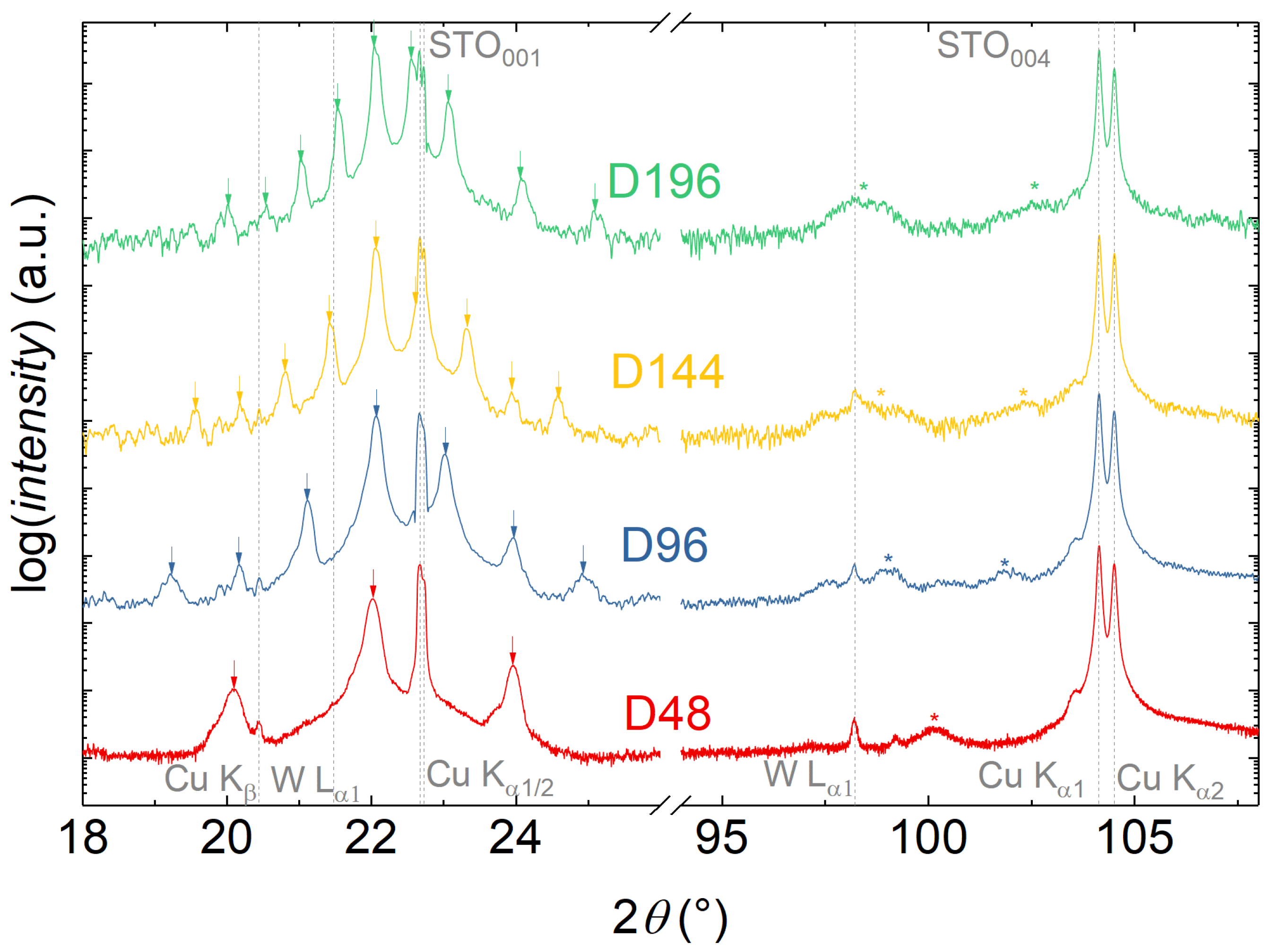
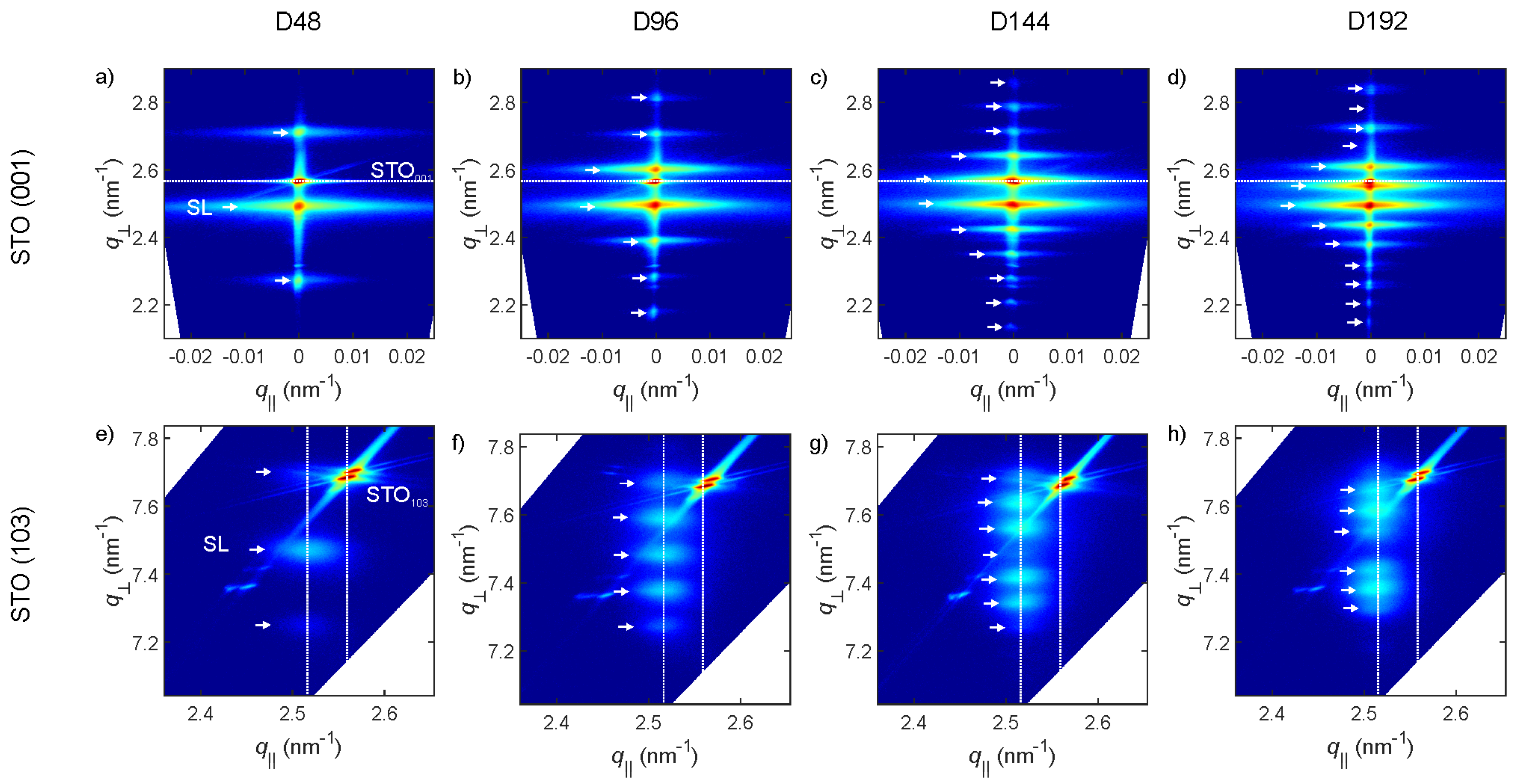
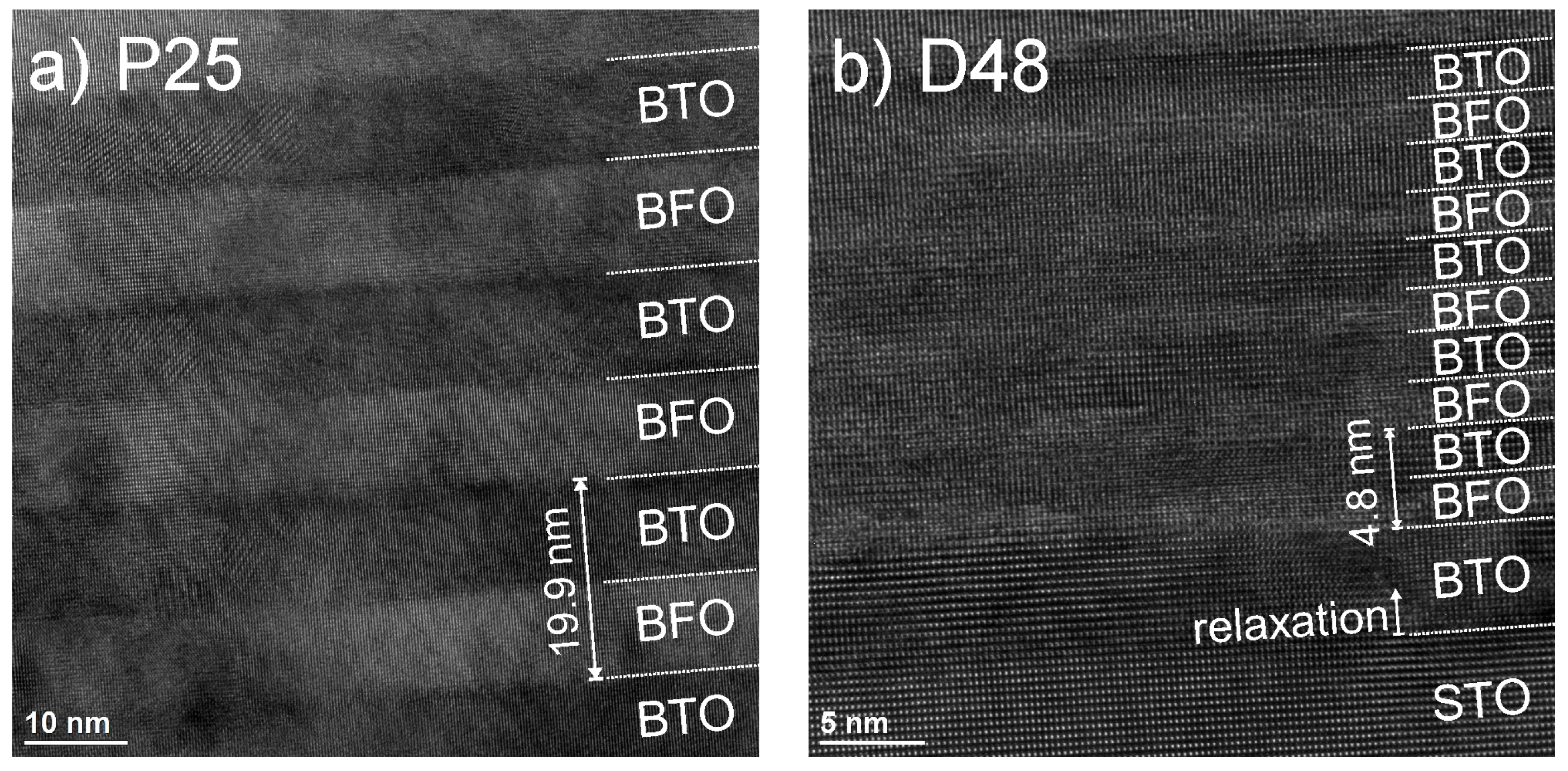
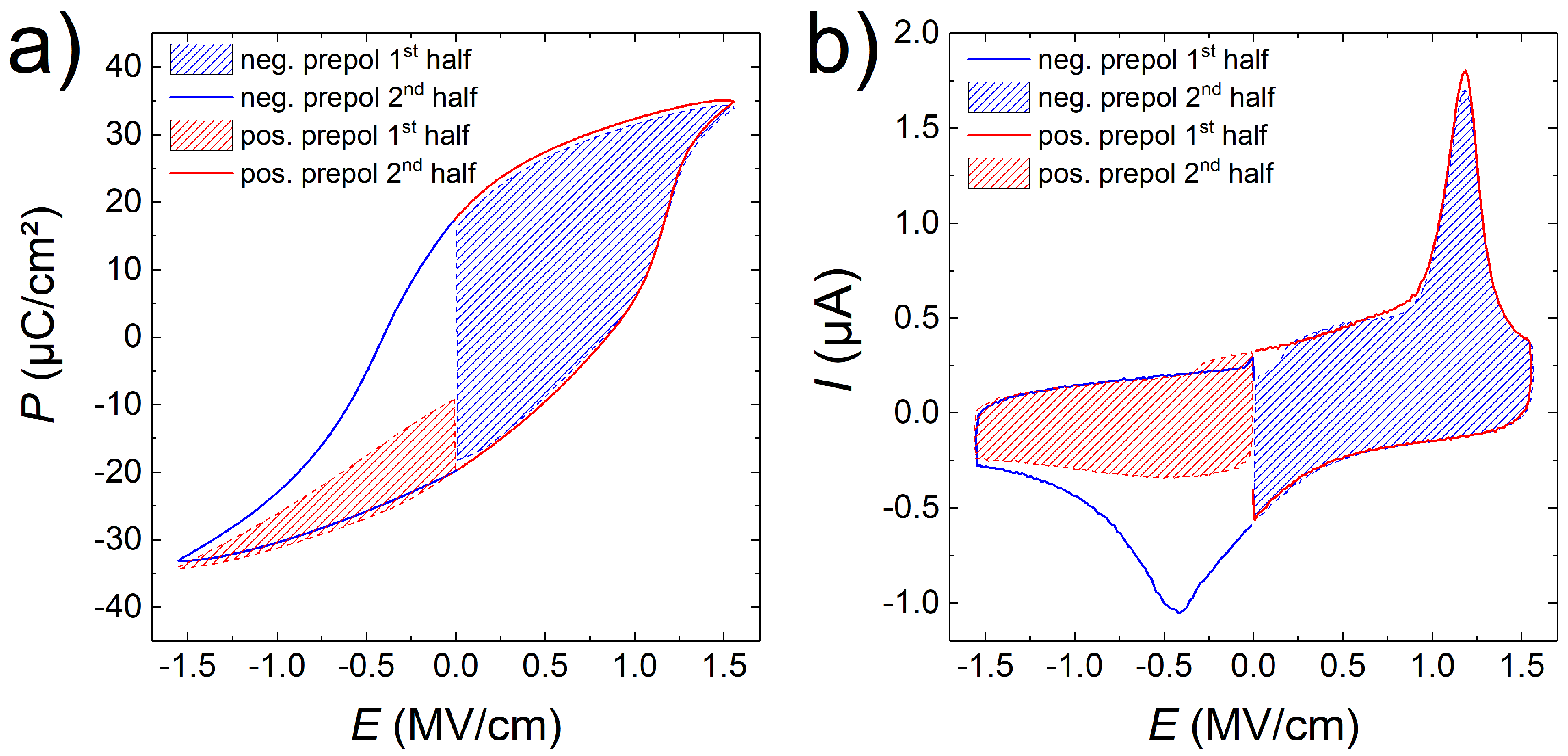
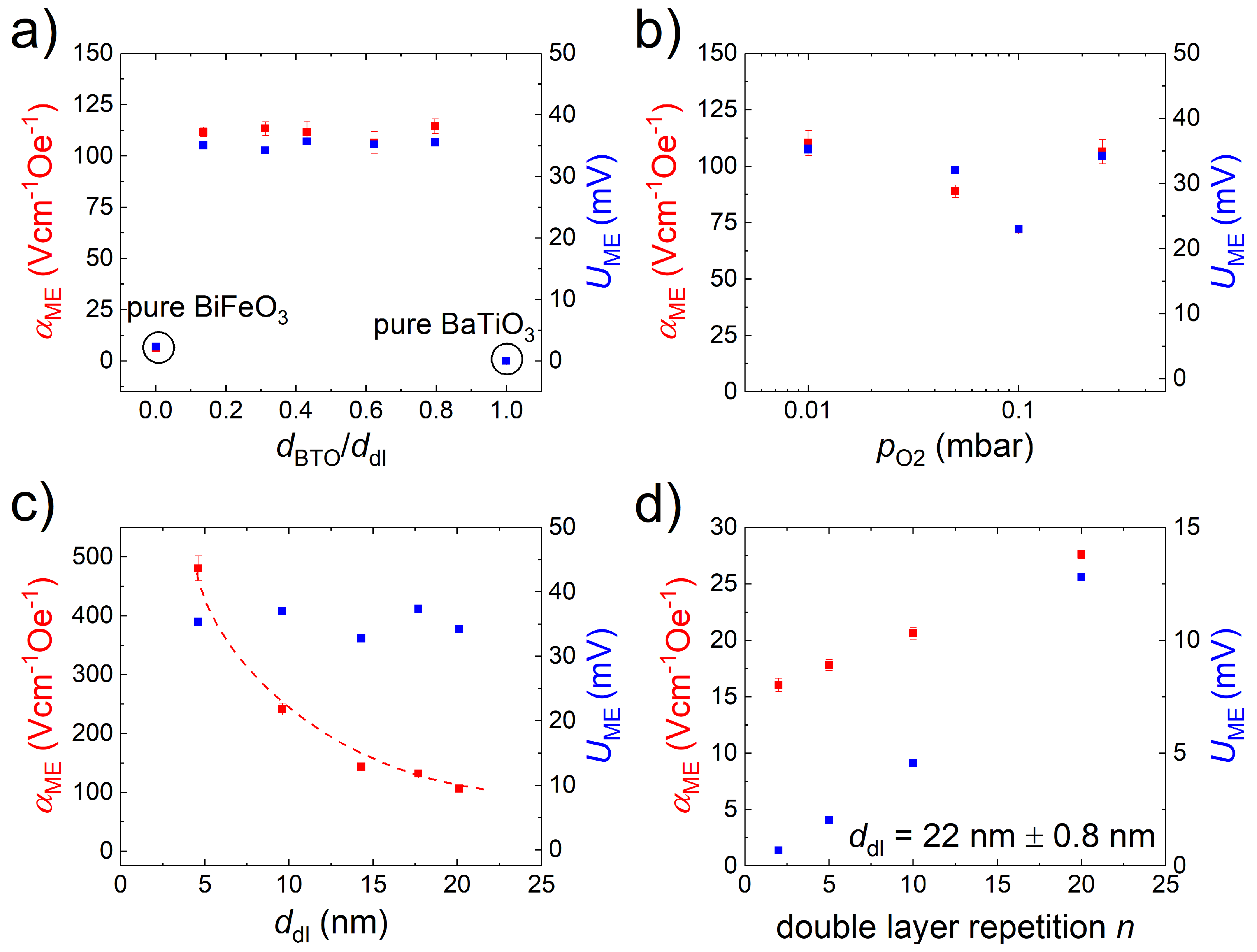
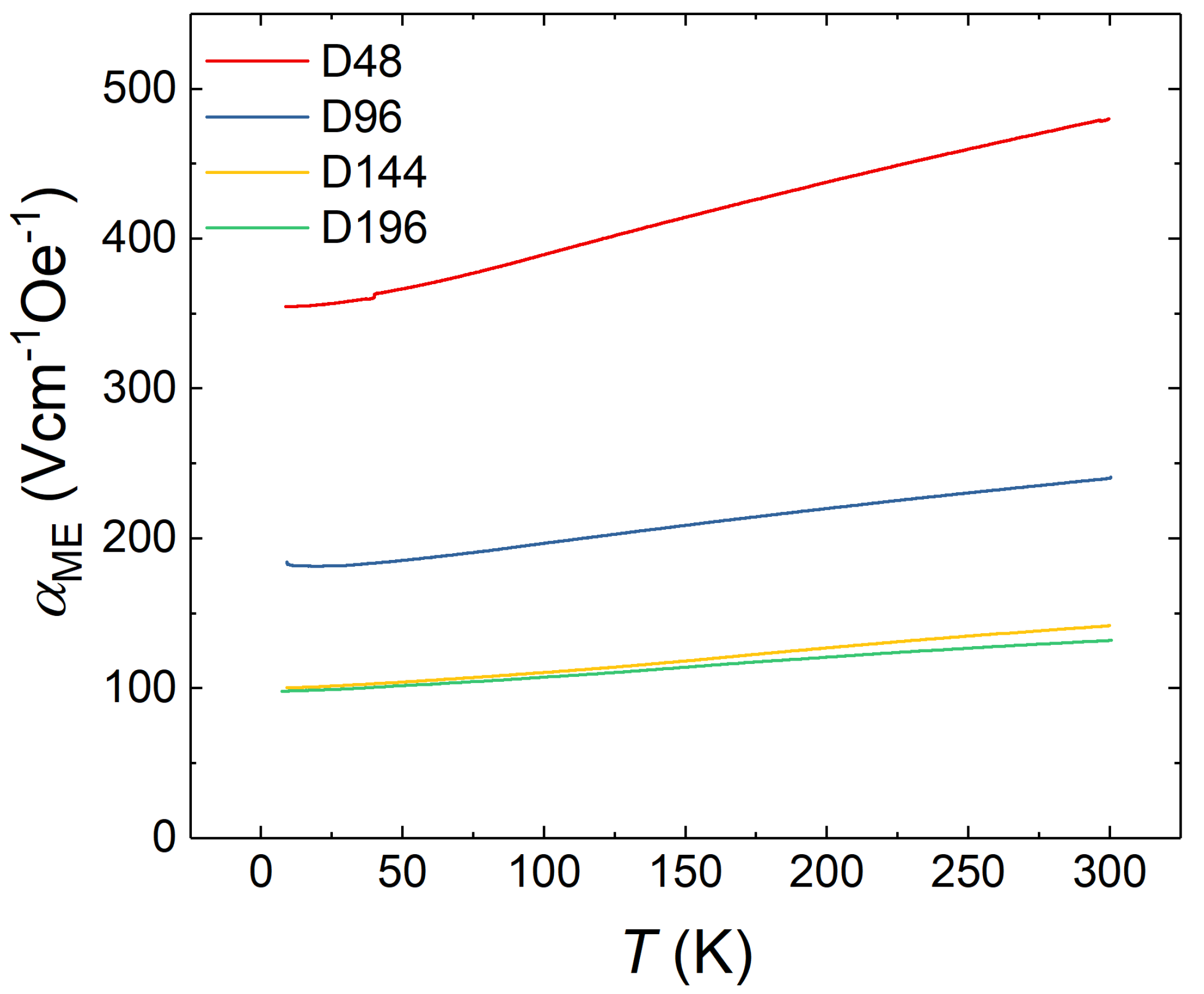

| Sample Name | Series | |||
|---|---|---|---|---|
| R09 | ratio | 18 | 2 | 0.25 |
| R07 | ratio | 14 | 6 | 0.25 |
| R03 | ratio | 6 | 14 | 0.25 |
| R01 | ratio | 2 | 18 | 0.25 |
| P25 | 10 | 10 | 0.25 | |
| P10 | 10 | 10 | 0.10 | |
| P05 | 10 | 10 | 0.05 | |
| P01 | 10 | 10 | 0.01 | |
| D48 | 2.4 | 2.4 | 0.25 | |
| D96 | 4.8 | 4.8 | 0.25 | |
| D144 | 7.2 | 7.2 | 0.25 | |
| D192 | 9.6 | 9.6 | 0.25 |
| Sample Name | |||||
|---|---|---|---|---|---|
| R09 | 0.066 | 4.00 | |||
| R07 | 0.038 | 3.98 | |||
| R03 | 0.123 | 3.97 | |||
| R01 | 0.207 | 3.96 | |||
| P25 | 0.085 | 3.97 | |||
| P10 | 0.249 | - | - | 4.00 | |
| P05 | 0.062 | 3.99 | |||
| P01 | 0.457 | - | - | 3.97 | |
| D48 | 0.048 | - | - | 3.97 | |
| D96 | 0.086 | 3.99 | |||
| D144 | 0.088 | 3.97 | |||
| D192 | 0.089 | 3.97 |
| Sample Name | ||||||
|---|---|---|---|---|---|---|
| R09 | ||||||
| R01 | ||||||
| P25 | ||||||
| D48 |
© 2020 by the authors. Licensee MDPI, Basel, Switzerland. This article is an open access article distributed under the terms and conditions of the Creative Commons Attribution (CC BY) license (http://creativecommons.org/licenses/by/4.0/).
Share and Cite
Hohenberger, S.; Jochum, J.K.; Van Bael, M.J.; Temst, K.; Patzig, C.; Höche, T.; Grundmann, M.; Lorenz, M. Enhanced Magnetoelectric Coupling in BaTiO3-BiFeO3 Multilayers—An Interface Effect. Materials 2020, 13, 197. https://doi.org/10.3390/ma13010197
Hohenberger S, Jochum JK, Van Bael MJ, Temst K, Patzig C, Höche T, Grundmann M, Lorenz M. Enhanced Magnetoelectric Coupling in BaTiO3-BiFeO3 Multilayers—An Interface Effect. Materials. 2020; 13(1):197. https://doi.org/10.3390/ma13010197
Chicago/Turabian StyleHohenberger, Stefan, Johanna K. Jochum, Margriet J. Van Bael, Kristiaan Temst, Christian Patzig, Thomas Höche, Marius Grundmann, and Michael Lorenz. 2020. "Enhanced Magnetoelectric Coupling in BaTiO3-BiFeO3 Multilayers—An Interface Effect" Materials 13, no. 1: 197. https://doi.org/10.3390/ma13010197
APA StyleHohenberger, S., Jochum, J. K., Van Bael, M. J., Temst, K., Patzig, C., Höche, T., Grundmann, M., & Lorenz, M. (2020). Enhanced Magnetoelectric Coupling in BaTiO3-BiFeO3 Multilayers—An Interface Effect. Materials, 13(1), 197. https://doi.org/10.3390/ma13010197






